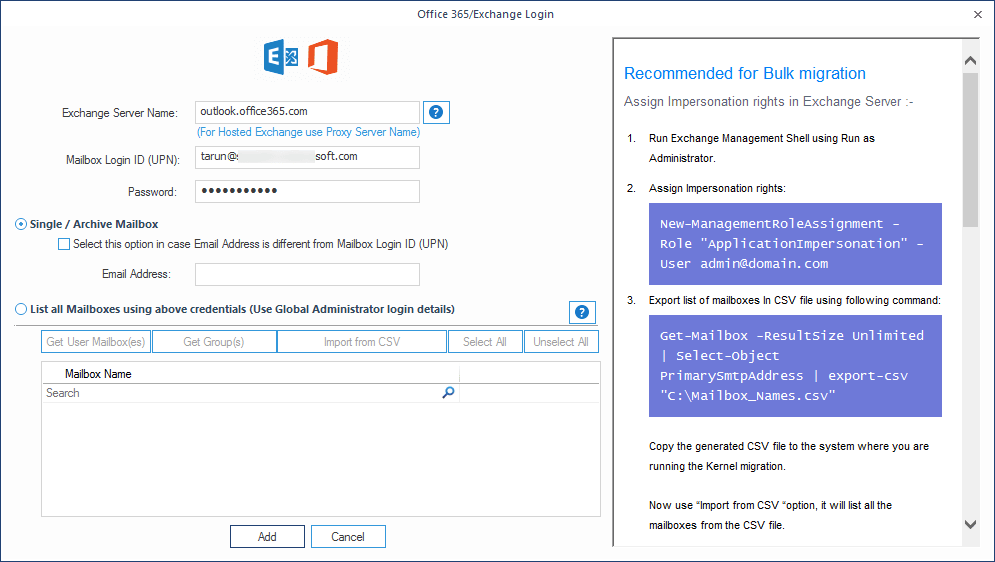

- #IMPORT ARCHIVES OUTLOOK TO OFFICE 365 HOW TO#
- #IMPORT ARCHIVES OUTLOOK TO OFFICE 365 PASSWORD#
- #IMPORT ARCHIVES OUTLOOK TO OFFICE 365 OFFLINE#
You can use the Office 365 Import service to import the data to mailboxes in your Office 365 organization ($2 per GB of data).

Once received they will upload the data to a temporary Azure storage location.
Drive shipping: Here you copy the PST files to a BitLocker-encrypted hard drive and then manually send the drive to Microsoft. After, use the Office 365 Import service to transfer the PST data to mailboxes in your Office 365 organization for free. Network upload: Upload your PST files to a temporary Azure storage location. In Office 365, there’s a built-in tool to import PST files to Exchange Online. If a PST gets unlocked, it can be loaded into Outlook by any user, which is a point to remember. #IMPORT ARCHIVES OUTLOOK TO OFFICE 365 PASSWORD#
Security concerns: PST file encryption and password protection is readily evaded by even an amateur hacker using typical methods and tools. Compliance issues: many businesses can’t implement retention policies, and legal departments struggle to ensure they have the correct data to defend cases. Attackers easily circumvent encrypted and password-protected files. Significant security risk: Portability of PSTs exposes organizations to data leakage. Hinder business changes: PSTs hamper modern client architectures involving multiple devices, VDI, and BYOD. They’re notoriously inefficient: IT teams trying to centralize PSTs using NAS and/or file servers risk data loss, file corruption, and Outlook speed reduction. Management issues: PST files are not centrally managed so there it’s hard to decipher how many exist in the infrastructure, where they are, or if they’re corrupt. There are a lot of issues with PST files: This is so to preserve the data securely in a compliance-regulated way without the problem of a shadow IT, which is when data and files are stored in many different locations and aren’t discoverable in a single place. Most PST files are ancient, saved on a network share like the user’s home drive, like locally, Azure, or OneDrive for Business.ĭuring an Office 365 migration, organizations want to get rid of PST files and migrate them to an Exchange Online mailbox or archive. In my line of work, I see my customers have a vast amount of local PST files in their environment. With heightened regulation and compliance restrictions in recent years, it seems unthinkable that a mailbox format could become adopted by larger organizations without being managed centrally, backed up correctly, and controlled in line with administrative best practices.Īnyone with basic intel of their personal computer’s file structure can make amendments with ease, such as copying, moving, and creating extra PSTs. For example, when you’re offline, you can still access all emails, calendar data, and contacts downloaded.įor step-by-step advice on moving PST data to the Microsoft cloud, please read my PST file migration guide What are the concerns with PST Files? #IMPORT ARCHIVES OUTLOOK TO OFFICE 365 OFFLINE#
You may have an Offline Outlook Data File (.ost), which is used by Outlook desktop clients to synchronize and cache copies of online folders for local use. If you have an Office 365, Exchange, Outlook, or Hotmail account, which isn’t accessed by POP or IMAP you won’t have a PST file.

In Outlook 2013 and earlier versions, IMAP accounts also used an Outlook Data File (.pst). PST files are often referred to as a personal storage file or personal folders, a local repository saved on the client itself. How Third-Party Migration Tools can helpĪ PST File, or some may refer to it as an Outlook Data File (.pst), contains messages and other Outlook items, like tasks, calendar items, etc.
#IMPORT ARCHIVES OUTLOOK TO OFFICE 365 HOW TO#
How to migrate PST files to Office 365?.







 0 kommentar(er)
0 kommentar(er)
